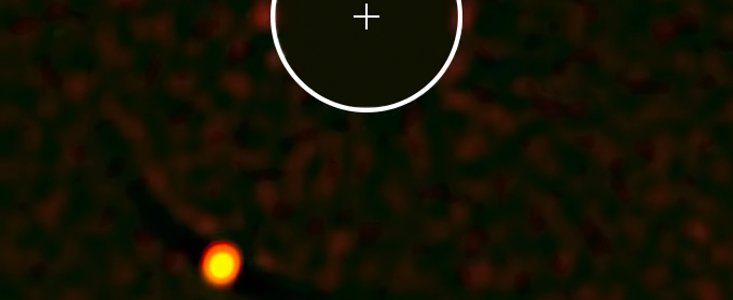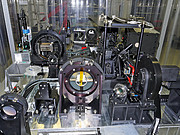Mitteilung
SPHERE enthüllt seinen ersten Exoplaneten
6. Juli 2017
Einer der anspruchsvollsten und aufregendsten Bereiche der Astronomie ist heutzutage die Suche nach Exoplaneten – also nach anderen Welten, die andere Sterne umkreisen. Der Exoplanet HIP 65426b ist kürzlich mit dem SPHERE-Instrument des Very Large Telescope (VLT) der ESO entdeckt worden. SPHERE steht für Spectro-Polarimetric High-contrast Exoplanet REsearch instrument. Etwa 385 Lichtjahre von uns entfernt, ist HIP 65426b der erste Planet, den SPHERE gefunden hat [1] – und er stellt sich als ein besonders interessanter heraus.
Der Planet ist warm (zwischen 1000 und 1400 Grad Celsius) und hat sechs bis zwölf Mal die Masse von Jupiter. Er scheint eine sehr staubige, mit dichten Wolken gefüllte Atmosphäre zu haben und kreist um einen heißen, jungen Stern, der überraschend schnell rotiert. Für sein Alter ungewöhnlich, scheint der Stern nicht von einer Trümmerscheibe umgeben zu sein, und der Mangel an einer solchen Scheibe wirft verwirrende Fragen darüber auf, wie der Planet wohl überhaupt entstand. Er könnte sich in einer Scheibe von Gas und Staub gebildet haben, und als sich diese Scheibe schnell auflöste, interagierte er mit anderen Planeten und landete in einer entfernteren Umlaufbahn, in der wir ihn jetzt sehen können. Alternativ könnten sich der Stern und der Planet zusammen als ein Doppelsystem gebildet haben, in dem der massereichere Bestandteil den anderen Möchtegern-Stern daran hinderte, genug Materie anzusammeln, um wirklich ein Stern zu werden. Die Entdeckung des Planeten gibt Astronomen die Möglichkeit, die Zusammensetzung und Lage der Wolken in seiner Atmosphäre zu untersuchen und die Theorien zur Entstehung, Entwicklung und der Physik von Exoplaneten zu prüfen.
SPHERE ist ein leistungsfähiger Planetenfinder, der am Hauptteleskop 3 des VLT installiert ist. Seine wissenschaftliche Zielsetzung ist es, mit der Direktabbildungs-Methode [2] neue Gasplaneten um nahe Sterne zu entdecken und zu untersuchen. Diese Methode zielt darauf ab, auf direktem Wege Bilder von Exoplaneten und von Trümmerringen um Sterne herum aufzunehmen, etwa so, als würde man ein Foto machen. Die direkte Abbildung von Exoplaneten ist schwierig, denn das Licht eines Sterns ist so hell, dass das schwache Leuchten der ihn umkreisenden Planeten vom Sternlicht überstrahlt wird. Aber SPHERE ist geschickt so konzipiert, dass es dieses Hindernis umgeht und speziell nach dem polarisierten Licht sucht, das von einer Planetenoberfläche reflektiert wird.
Das Bild wurde als Teil des Durchmusterungsprogramms SHINE (SpHere INfrared survey for Exoplanets) aufgenommen. SHINE soll 600 junge, nahegelegene Sterne im Nahinfrarotbereich abbilden, indem es mit den hohen Kontrasten und der hohen Winkelauflösung von SPHERE neue Planetensysteme entdeckt, charakterisiert und erforscht, wie sie entstanden.
Endnoten:
[1] Eine ältere ESO-Pressemitteilung berichtete von einer Beobachtung mit SPHERE, die als Planet interpretiert wurde. Allerdings sind mittlerweile Zweifel an dieser Interpretation aufgekommen, und so gilt HIP 65426b aktuell als SPHEREs erste, verlässliche Exoplaneten-Entdeckung.
[2] Wenn Astronomen das Universum nach Exoplaneten durchsuchen, stehen ihnen dafür verschiedene Werkzeuge zur Verfügung. Viele Methoden zur Entdeckung von Planeten funktionieren nur indirekt: Astronomen können z.B. den verräterischen Helligkeitsabfall eines Sterns messen, wenn ein Planet vor ihm vorbeizieht, oder sie beobachten das winzige Wackeln, das von der Gravitationskraft eines jeden den Stern umkreisenden Planeten ausgelöst werden kann. Es gibt jedoch eine direktere Methode, einen Exoplaneten zu finden: die Direktabbildung.
Links
Kontaktinformationen
Gaël Chauvin
Institut de Planetologie et d'Astrophysique de Grenoble (IPAG)
BP 53, 38041 Grenoble Cedex 9, France
Tel: +33 6 4551 8209
E-Mail: gael.chauvin@univ-grenoble-alpes.fr
Jean-Luc Beuzit
Institut de Planetologie et d'Astrophysique de Grenoble (IPAG)
BP 53, 38041 Grenoble Cedex 9, France
Tel: +33 6 8739 6285
E-Mail: jean-luc.beuzit@univ-grenoble-alpes.fr
Richard Hook
ESO Public Information Officer
Garching bei München, Germany
Tel: +49 89 3200 6655
Mobil: +49 151 1537 3591
E-Mail: rhook@eso.org
Über die Mitteilung
| ID: | ann17041 |


